In my work, I am committed to interdisciplinary scholarship that straddles the fields of History, Political Science, International Relations, International Law, and Geography.
Arctic History
To stimulate discussion and debate about Arctic security in a robust historical context, my main research efforts analyze how sovereignty and security threats to Canada’s North have changed, evolved, and resurfaced over the last seventy years, forcing successive governments to respond. During the Second World War and the early years of the Cold War, the advances of the Axis forces and the danger posed by the Soviet Union and its massive arsenal finally led strategists to portray the northern approaches as the undefended roof of the continent rather than a natural defensive barrier. In the 1970s and 1980s Canada’s defence planners acknowledged the Soviet menace in the Arctic, but emphasized new environmental and sovereignty threats after the Northwest Passage transits of the oil tanker S.S. Manhattan in 1969 and the U.S. Coast Guard cutter Polar Sea in 1985. The interrelationship between sovereignty and security continues to evolve as the Arctic and circumpolar geopolitics change, but the distinction between the two concepts – and the precise nature of their interaction – is seldom explained in a systematic way that is attentive to historical experience and decision-making.
Although most of the current debate over Arctic sovereignty and security anticipates the future, history continues to inform perceptions of Canada’s legal position, relationships, and priorities. Assumptions about what Canada should have done, and therefore must do, to protect its sovereignty saturate political commentary. After all, the current “crisis” is predicated on the notion that previous governments failed to protect Canadian interests. When Prime Minister Harper came to office in early 2006, his “use it or lose it” refrain became a dominant political message. Tapping into primordial national anxieties about sovereignty, this phrase resonated with southern Canadians largely ignorant about Arctic affairs but easily convinced that military capabilities could shield Canada from “the perfect storm” brewing in the circumpolar north. The logic of “defending sovereignty” from foreign challenges also brought a shift from past governments that had favoured recognition − persuading others to accept our claims without building the capacity to enforce them – to a Harper government that favours enactment.
If popular ignorance about the Arctic facilitates a message of alarmism, as some commentators allege, this is compounded by a dearth of knowledge about past state promises, practices, and relationships. My work critically assesses the dynamics that generated perceived crises historically. By calling something a sovereignty or security crisis, an actor elevates an issue from the realm of low politics (bounded by democratic rules and decision-making procedures) to the realm of high politics (characterized by urgency, priority and a matter of life and death). The line between risk management – preventing potential risks from developing into concrete, acute threats to Canada – and the perception of “actual” threats to sovereignty and security becomes blurred. Is anxiety about “using or losing” our Arctic inheritance more revealing of the Canadian psyche (particularly our chronic lack of confidence) than of objective realities? Who are the alleged “enemies” to Canada’s national interests, and what is the nature of their challenge? Does the discourse of “crisis” encourage a disproportionate emphasis on national defence at the expense of a broader suite of social, economic and diplomatic initiatives?
These questions lay at the heart of Arctic Front: Defending Canada in the Far North, my co-authored book with distinguished Northern historians Ken Coates and Bill Morrison, as well as political scientist Greg Poelzer, which won the 2008 Donner Prize for the best book in Canada on public policy. The jury citation read:
A truly integrated volume by four of Canada’s leading Northern specialists, Arctic Front is a clarion call to all Canadians about our endangered Arctic region, challenging the country to step away from the symbols and myth making of the past and toward the urgent political, environmental and economic realities of the 21st century.
Unquestionably, this book deals with a subject of major public importance and interest. This is a substantial and accessible book that should be widely read by everyone interested in an insightful introduction to this subject.
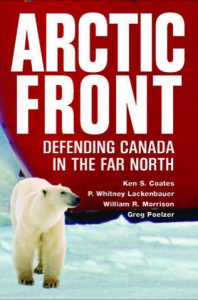 Of the five chapter book, I wrote chapters 2-3, half of chapter 4, and substantively revised chapter 5 (on recent trends) when the author of the initial draft adopted an “alarmist” tone. Although I dissented with some of the conclusions, the authorial team and the publisher decided that it was best to produce a single conclusion. To articulate my own views on contemporary Arctic policy trends, I published subsequent research through a Canadian International Council fellowship and an ArcticNet project.
Of the five chapter book, I wrote chapters 2-3, half of chapter 4, and substantively revised chapter 5 (on recent trends) when the author of the initial draft adopted an “alarmist” tone. Although I dissented with some of the conclusions, the authorial team and the publisher decided that it was best to produce a single conclusion. To articulate my own views on contemporary Arctic policy trends, I published subsequent research through a Canadian International Council fellowship and an ArcticNet project.
Canada’s dominant international relationship in the Arctic is with the United States. How policy-makers conceptualize US intentions and Canadian responses informs expectations for the future. Studies that pay careful attention to process produce “lessons learned” that (re)shape our understanding of Cold War relations. Like the historiography more generally, they yield two main interpretations. Which side of the debate one chooses to accept influences the lessons that guide future scenario-setting and policy-making. On the one hand, contributors like Bernd Horn and Adam Lajeunesse pick up on themes first raised by Donald Creighton and Shelagh Grant, which intimate that the US disregarded Canadian sensitivities and interests. By extension, this interpretation suggests that Canada must adopt activist strategies to entrench and protect its Arctic interests against American challenges. Incompatible interests demand that Canada consolidate and defend its sovereignty outside of cooperative frameworks unless the US concedes its legal arguments in favour of Canada’s. On the other hand, I lead a new generation of historians who promote a narrative of mutual understanding and cooperation over one of conflict. By seeing Canadian and American interests as generally compatible (and friction as inevitable but manageable), I suggest that a history of diplomacy and successful working relationships explains how and why Canada’s security and sovereignty interests have been enhanced since the Second World War. Quiet diplomacy and practical, bilateral solutions allayed most of the acute “crises” concerns that arose. Accordingly, decision-makers today might seek to perpetuate a long tradition of cooperation with the United States that respects legal differences and seeks practical agreements without prejudicing either country’s national or international interests.
Work with my former graduate student (now a professor at Sheridan College Institute of Technology and Advanced Learning) Peter Kikkert corrects what, in our view, is a problematic narrative suggesting a conflictual Canada-United States relationship in the Arctic. Our chapter “Sovereignty and Security: Canadian Diplomacy, the United States, and the Arctic, 1943-68” argued that Canadian policy makers, particularly in the Department of External Affairs, admirably balanced Canadian sovereignty interests with the continental security from the early Cold War to the eve of the Manhattan voyage in 1969. Although Canada compromised on some issues, an underlying spirit of mutual respect allowed Canada to preserve – and indeed strengthen – its sovereignty while accommodating its American ally insofar as its national interests allowed. This approach secured United States acquiescence to Canadian territorial sovereignty claims, despite America’s rejection of the sector principle. When the emphasis shifted to maritime issues in the 1950s, the legal dilemma proved intractable but a functional approach, predicated on “agreeing to disagree” over the status of the waters of the Arctic archipelago, maintained a cooperative bilateral relationship. Rather than seeing Canadian decision-making in the 1940s and 1950s as failing to secure American acquiescence to Canada’s future claim to the Northwest Passage, a more positive appraisal recognizes how careful diplomacy positioned Canada so that it could implement a functional approach under Prime Minister Pierre Trudeau in the early 1970s and declare straight baselines under Prime Minister Brian Mulroney in 1985. While postwar diplomatic actions appear ad hoc, reactionary, and tentative, they were appropriately suited to a complex situation. Officials at External Affairs acknowledged Canada’s limitations but managed to steer a prudent and practical course laying the groundwork for future assertions of Canadian jurisdiction and sovereignty in the Arctic.
I have begun to test this thesis about the bilateral defence relationship in the Arctic through a series of grounded case studies. For example, Kikkert and I critically examined Task Force 80 and the High Arctic resupply mission of 1948 and revealed that, rather than sacrificing sovereignty in the interests of continental security, the Canadian government scrutinized and monitored American defence activities in the Arctic, retaining an appropriate level of control. Oversights, missteps, and miscommunication occurred on both sides, but officials derived important lessons from the 1948 mission that guided subsequent resupply activities, setting the course for an increasingly smooth operational relationship.
Although functional cooperation prevailed historically and continues today, thorny international legal questions remain. Current commentators who suggest that Canada should have secured its claims more effectively, given that Canada could have acted differently, and that this would have yielded a stronger Canadian claim today, practice “what if” history. As an historian, I insist on the primacy of historical context — the relationships that existed at the time, prevailing norms of international law, and cost-benefit analyses of possible courses of action – in making judgments.
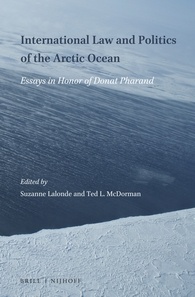 My book chapter with Kikkert on “The Dog in the Manger – and Letting Sleeping Dogs Lie: The United States, Canada and the Sector Principle, 1924-1955,” which was included in a festschrift to eminent legal scholar Donat Pharand, re-evaluates bilateral relations over the “sector” approach to dividing the Arctic using straight lines to the North Pole. Although most Canadian officials realized that the sector principle was legally indefensible, and understood the need for effective occupation in the Arctic, the sector served a political purpose by setting constraints on potential US claims to undiscovered islands. The Americans privately noted their disagreement with Canada’s Arctic claims and its use of the principle in the 1920s and 1930s, but they chose not to jeopardize their relationship with their northern neighbour over polar sovereignty. After the Second World War, the U.S. maintained a balanced course that upheld its broader political and strategic relationship with Canada without setting legal precedents that would have jeopardized the American legal position vis-à-vis the Antarctic and Arctic Russia. Our research argues that between 1924 and 1955 the US carefully maintained an effective defence of legal position that avoided a Pyrrhic victory. As the Cold War started, the US quietly and privately conceded to Canada what it was not prepared to acknowledge in international law: a relaxed interpretation of effective occupation and ownership of uninhabited territories in polar regions than the Hughes Doctrine allowed.
My book chapter with Kikkert on “The Dog in the Manger – and Letting Sleeping Dogs Lie: The United States, Canada and the Sector Principle, 1924-1955,” which was included in a festschrift to eminent legal scholar Donat Pharand, re-evaluates bilateral relations over the “sector” approach to dividing the Arctic using straight lines to the North Pole. Although most Canadian officials realized that the sector principle was legally indefensible, and understood the need for effective occupation in the Arctic, the sector served a political purpose by setting constraints on potential US claims to undiscovered islands. The Americans privately noted their disagreement with Canada’s Arctic claims and its use of the principle in the 1920s and 1930s, but they chose not to jeopardize their relationship with their northern neighbour over polar sovereignty. After the Second World War, the U.S. maintained a balanced course that upheld its broader political and strategic relationship with Canada without setting legal precedents that would have jeopardized the American legal position vis-à-vis the Antarctic and Arctic Russia. Our research argues that between 1924 and 1955 the US carefully maintained an effective defence of legal position that avoided a Pyrrhic victory. As the Cold War started, the US quietly and privately conceded to Canada what it was not prepared to acknowledge in international law: a relaxed interpretation of effective occupation and ownership of uninhabited territories in polar regions than the Hughes Doctrine allowed.
International legal issues extended beyond Canada’s relationship with its North American neighbour. In 1957, Indonesia shocked the maritime powers of the world when it drew straight baselines enclosing the archipelagic state. My article with Kikkert on “Archipelagic Analogs? Indonesian Baselines, Canadian Arctic Sovereignty, and the Framing of Mental Maps, 1957-62,” submitted for peer-review this summer, looks at how Canadian legal experts evaluated the case, debated the prospects of its success, and anticipated the types of precedents it might set – particularly for the Canadian Arctic. Although Indonesia proved an imperfect archipelagic analog, its actions encouraged officials to contemplate the extent of Canada’s Arctic domain. Balancing national interests, alliance politics, and competing interpretations of international law, Canadian decision-makers devised a prudent, pragmatic approach that allowed others to push the boundaries of maritime law and established a foundation so that Canada could secure sovereignty over its Arctic waters.
The implications of Canada’s responses to perceived Arctic “threats” reach beyond the national and international level. Sovereignty and security projects, conceived from afar and implemented locally, have unintended consequences “on the ground.” Another area of my published work connects with the burgeoning field of environmental history. Given the low standard of contact between environmental and military historians, it is unsurprising, if regrettable, that scholars have neglected the relationship between military activity and natural landscapes in Canada. “The Cold War on Canadian Soil: Militarizing a Northern Environment,” an article co-authored with geographer Matthew Farish and published in Environmental History, sought to open space for an environmental history of militarism and militarization. Focusing on the Cold War and its aftermath, the essay documented the history of military activity on northern Canadian soil, specifically examining a set of crucial projects and operations which redefined physical terrain and associated understandings of nature. As northern nature was viewed through a series of shifting strategic perspectives, it remained a target of state-driven modernization linked consistently to military objectives.
Cold War militarization was a profoundly modern endeavour, a state-driven attempt to transform and impose order on an unruly landscape. As James C. Scott notes in Seeing like a State, transforming human life – and its environmental contexts – inevitably fails when conducted from a distance, ignoring the complexities of local culture and nature. The modernization of the Cold War Arctic reflects this tendency to seek legibility in a landscape and to enrol it in classic political “responsibilities.” I co-authored several papers with Dr. Farish exploring these themes. “High Modernism in the Arctic: Planning Frobisher Bay and Inuvik,” in the Journal of Historical Geography, examines two overlapping attempts to transfer high modernist architecture, planning, and social structure to the north. In the specific Canadian sites of Frobisher Bay (now Iqaluit) and Inuvik, military necessity combined with broader governmental interest in new-town plans that borrowed heavily from the universal language of modernization. In our forthcoming chapter “Western Electric Turns North: Technicians and the Transformation of the Cold War Arctic,” we look specifically at the case of the Distant Early Warning (DEW) Line. In planning the radar network, military and corporate employees reimagined the Arctic as a functional space, placing unquestioned faith in the transformative powers of modern technology to reconfigure or simply overcome a ‘hostile’ environment. To mobilize the Arctic as a facet of the continental defence web, planners rendered the region analogous to other locations – from laboratories in New Jersey to cornfields in Illinois. The result was a legible space upon which they could inscribe designs and assumptions. Realizing these technical aspirations required the production and transmission southward of details derived from Arctic site visits, yielding new forms of usable geographical knowledge. As they transcended and blurred national, regional, and local scales, planners, engineers, logisticians, and technicians muddied the boundaries between north and south, devising techniques, erecting infrastructure, and implementing practices in a deliberate effort to overcome the particularities of climate and terrain. Through the perceived triumph of technology over the northern environment, the DEW Line embodied the hubris of technopolitics and the assimilation of the remotest reaches of North America into a truly continental grid of defence, science, and state control.
Relationships between military personnel, technology, and the environment had dramatic impacts on local populations. My chapter on the “Politics of Race, Gender and Sex” explored how the federal government perceived and attempted to regulate the relationships between African American soldiers and Aboriginal women in Northern Canada during and after the Second World War. I have expanded upon this case study in a chapter for a forthcoming volume on race and Canadian foreign policy, adding analysis of state paternalism and Canadian Inuit in early postwar defence projects. With Ryan Shackleton, an historical consultant in Ottawa, I examined Inuit-air force relations in the Qikiqtani (Baffin Island and High Arctic) region from the Second World War to the mid-1960s. Drawing upon oral histories, archival documents, and newspapers, we explored the impacts of “military modernization” on the Inuit communities of Frobisher Bay (Iqaluit) and Resolute. Our study suggests that relationships were neither uniformly positive nor negative. At Frobisher Bay, the military hub of the eastern Arctic, defence activities drew Inuit people into the web of modern urban life. The expansion of the military’s footprint in the decade after the Second World War reshaped boundaries, expectations, and tastes of Frobisher’s inhabitants. It also changed the socio-economic and cultural geographies of southern Baffin Island more generally. In Resolute, the establishment of the Inuit community immediately adjacent to an RCAF base had unexpected consequences. Inuit mixed both tradition and modernity when incorporating the wage economy into their daily lives. In some respects, Resolute served as a model for transitioning Inuit society. Although military planners now respect the cultural needs of local inhabitants and take into account the environmental impacts of all Arctic activities, we reinforce the basic message that planners need to consider local impacts when conceiving military projects today.
“The Military as Nation-Builder: The Case of the Canadian North,” the published version of my 2013 Ross Ellis Memorial lecture, charts a long-term pattern of positive military contributions to Northern life: improved communications, transportation, training, and community-development. It explores the social or nation-building role of the Canadian Forces in the region, and the expectation that military activities contribute to the government’s broader nation-building objectives. 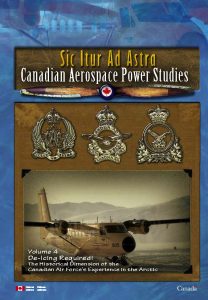 I continue to expand this work through various projects discussed in the sections on current and future research.I have edited (and contributed to) various collections designed to reach non-traditional academic audiences. In cooperation with Major Bill March of the Canadian Forces Air Warfare Centre, I edited a volume entitled De-Icing Required: The Canadian Air Force’s Experience in the Arctic, which appeared as part of the Canadian Aerospace Power Studies Series. The chapters demonstrate how RCAF involvement in the Arctic fits within the longer and broader history of Canadian activities in the region. For example, my chapter with Daniel Heidt examined the important (and contentious) role of civilian airlift contractors in the construction and early operational phases of the DEW Line. The Canadian government, conscious of nation-building possibilities, secured guarantees from the US that Canadian carriers would be utilized “to the fullest extent practicable.” America’s power of the purse sometimes compromised Canada’s power to control specific tenders, but investments in new aircraft and the need for continued work ensured that Canadian companies jealously guarded and policed American airlift competition independently of Ottawa. American DEW Line contract dollars afforded Canadian commercial carriers the opportunity to expand while concurrently buttressing Canadian Arctic sovereignty. Although contexts have changed, important lessons learned during the DEW Line civil airlift remain noteworthy.
I continue to expand this work through various projects discussed in the sections on current and future research.I have edited (and contributed to) various collections designed to reach non-traditional academic audiences. In cooperation with Major Bill March of the Canadian Forces Air Warfare Centre, I edited a volume entitled De-Icing Required: The Canadian Air Force’s Experience in the Arctic, which appeared as part of the Canadian Aerospace Power Studies Series. The chapters demonstrate how RCAF involvement in the Arctic fits within the longer and broader history of Canadian activities in the region. For example, my chapter with Daniel Heidt examined the important (and contentious) role of civilian airlift contractors in the construction and early operational phases of the DEW Line. The Canadian government, conscious of nation-building possibilities, secured guarantees from the US that Canadian carriers would be utilized “to the fullest extent practicable.” America’s power of the purse sometimes compromised Canada’s power to control specific tenders, but investments in new aircraft and the need for continued work ensured that Canadian companies jealously guarded and policed American airlift competition independently of Ottawa. American DEW Line contract dollars afforded Canadian commercial carriers the opportunity to expand while concurrently buttressing Canadian Arctic sovereignty. Although contexts have changed, important lessons learned during the DEW Line civil airlift remain noteworthy.
Another edited book, Canada and Arctic Sovereignty and Security: Historical Perspectives, provides an overview of leading historical research on Canadian Arctic security and sovereignty since the Second World War. It contains both previously published scholarship by senior scholars in the field (7 chapters) and previously unpublished, cutting edge research with a particular emphasis on “new scholars” (7 chapters). A previous editorial project – a special issue of the Journal of Military and Strategic Studies on “Arctic Sovereignty and Security: Past, Present, and Future” pursued similar ends with articles from serving military officers and academics.
I am also committed to making unpublished research and important archival collections available to scholars. For example, Gordon W. Smith, Ph.D. (1918-2000) dedicated much of his life to researching Canada’s sovereignty in the Arctic. 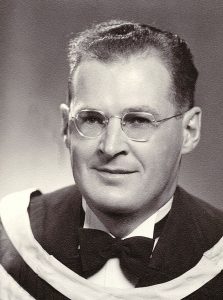 In mid-2008, the Joint Law Section at the Department of Foreign Affairs (DFAIT) suggested that I work with Professor Armand de Mestral, holder of the Jean Monnet Chair in the Law of International Economic Integration at McGill University, to determine what parts of Dr. Smith’s work should be in the public domain. Pursuant to this project, I have edited and published selections from his manuscript, A Historical and Legal Study of Sovereignty in the Canadian North and Related Law of the Sea Problems, which he first drafted in 1973 and remained incomplete at the time of his death in October 2000. This study may be considered the most comprehensive study on the subject and will be a valuable resource for senior undergraduate and graduate students, academics, and policy makers.
In mid-2008, the Joint Law Section at the Department of Foreign Affairs (DFAIT) suggested that I work with Professor Armand de Mestral, holder of the Jean Monnet Chair in the Law of International Economic Integration at McGill University, to determine what parts of Dr. Smith’s work should be in the public domain. Pursuant to this project, I have edited and published selections from his manuscript, A Historical and Legal Study of Sovereignty in the Canadian North and Related Law of the Sea Problems, which he first drafted in 1973 and remained incomplete at the time of his death in October 2000. This study may be considered the most comprehensive study on the subject and will be a valuable resource for senior undergraduate and graduate students, academics, and policy makers.
I edited Dr. Smith’s work on the Joint Arctic Weather Stations programme for publication in the Journal of Military and Strategic Studies in 2009, and the University of Calgary published an edited monograph, A Historical and Legal Study of Sovereignty in the Canadian North, 1870-1942, as part of its Northern Lights series in 2014. 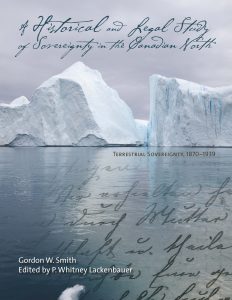 This massive volume documents the post-Confederation history of Canadian sovereignty in the North in more detail than any other source. It begins with the transfers of the northern territories to Canada in 1870 and 1880, their early organization and administration, their division into provisional districts by the Order in Council of 1895, and the boundary corrections necessary to organize and delimit these territories. The next section documents other activities by the Canadian Government during this early period, such as expeditions in the former Hudson’s Bay Company lands, the early expeditions of Lieutenant Gordon to Hudson Bay and Strait, and other government expeditions to northern waters such as those by Wakeham, Low, Bernier and Stefansson. The next six chapters examine causes for Canadian concern over the status of the Northern Territories, namely foreign whalers, the Yukon gold rush, the Alaska boundary dispute, and explorers in the north during the period from about 1870 through 1918. The following chapter explains the sector principle and the background of Canada’s sector claim. The next chapters consider the question of Danish sovereignty over Greenland and its relation to Canadian interests, Vilhjalmur Stefansson and his various plans for northern enterprises after World War I (with special emphasis on the reindeer and muskox projects in the north), the Ellesmere Island affair (1919-1921), the Wrangel Island affair (early 1920s), the question of sovereignty over the Sverdrup Islands, and the activities of American explorers in the Canadian North. Significant government activities in the north are documented, such as those of the Eastern Arctic Patrol, the Royal Canadian Mounted Police, and other Canadian Government expeditions, surveys, investigations and patrols in the region through Henry Larsen’s 1942-44 transit of the Northwest Passage.
This massive volume documents the post-Confederation history of Canadian sovereignty in the North in more detail than any other source. It begins with the transfers of the northern territories to Canada in 1870 and 1880, their early organization and administration, their division into provisional districts by the Order in Council of 1895, and the boundary corrections necessary to organize and delimit these territories. The next section documents other activities by the Canadian Government during this early period, such as expeditions in the former Hudson’s Bay Company lands, the early expeditions of Lieutenant Gordon to Hudson Bay and Strait, and other government expeditions to northern waters such as those by Wakeham, Low, Bernier and Stefansson. The next six chapters examine causes for Canadian concern over the status of the Northern Territories, namely foreign whalers, the Yukon gold rush, the Alaska boundary dispute, and explorers in the north during the period from about 1870 through 1918. The following chapter explains the sector principle and the background of Canada’s sector claim. The next chapters consider the question of Danish sovereignty over Greenland and its relation to Canadian interests, Vilhjalmur Stefansson and his various plans for northern enterprises after World War I (with special emphasis on the reindeer and muskox projects in the north), the Ellesmere Island affair (1919-1921), the Wrangel Island affair (early 1920s), the question of sovereignty over the Sverdrup Islands, and the activities of American explorers in the Canadian North. Significant government activities in the north are documented, such as those of the Eastern Arctic Patrol, the Royal Canadian Mounted Police, and other Canadian Government expeditions, surveys, investigations and patrols in the region through Henry Larsen’s 1942-44 transit of the Northwest Passage.
History yields important insights into the relationship between sovereignty and security. Since coming to office, the Harper government frequently references the “critical role” that the Canadian Forces play in asserting sovereignty. Should the burden of enforcing Canada’s Arctic sovereignty really be placed on the armed forces? Does a military presence actually contribute to our Arctic sovereignty? 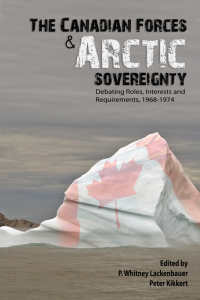 I compiled The Canadian Forces and Arctic Sovereignty: Debating Roles, Interests, and Requirements, 1968-1974 with then M.A. student Peter Kikkert, which challenges the misconception that a military “presence” is necessary to “defend” or enhance Canadian sovereignty in the Arctic. To facilitate debate and provide senior undergraduate and graduate students with access to the primary record, we decided to frame the book around recently declassified archival documents representing military, diplomatic, and political perspectives. We furnished a 43-page introduction to set the documentary record in historical context and to lay out the major debates, and subsequently offered our own assessment in the chapter “Building on ‘Shifting Sands’: The Canadian Armed Forces, Sovereignty, and the Arctic, 1968-72.” We show that officials in the Department of External Affairs expressed scepticism in the late 1960s and early 1970s that increased military capabilities and activities strengthen our sovereignty. The context has changed, but many of the underlying issues that they raised remain pertinent today. Legal officers at External Affairs warned that continuous talk about the need for a stronger Canadian Forces presence could actually undermine Canada’s sovereignty, by suggesting that Canada thought its claim weak. Does current rhetoric have the same unintentional, but unfortunate, effect?
I compiled The Canadian Forces and Arctic Sovereignty: Debating Roles, Interests, and Requirements, 1968-1974 with then M.A. student Peter Kikkert, which challenges the misconception that a military “presence” is necessary to “defend” or enhance Canadian sovereignty in the Arctic. To facilitate debate and provide senior undergraduate and graduate students with access to the primary record, we decided to frame the book around recently declassified archival documents representing military, diplomatic, and political perspectives. We furnished a 43-page introduction to set the documentary record in historical context and to lay out the major debates, and subsequently offered our own assessment in the chapter “Building on ‘Shifting Sands’: The Canadian Armed Forces, Sovereignty, and the Arctic, 1968-72.” We show that officials in the Department of External Affairs expressed scepticism in the late 1960s and early 1970s that increased military capabilities and activities strengthen our sovereignty. The context has changed, but many of the underlying issues that they raised remain pertinent today. Legal officers at External Affairs warned that continuous talk about the need for a stronger Canadian Forces presence could actually undermine Canada’s sovereignty, by suggesting that Canada thought its claim weak. Does current rhetoric have the same unintentional, but unfortunate, effect?
In conclusion, I consider my historical work on the Cold War Arctic as engaged research in the sense that I connect it to issues of contemporary relevance without abandoning the primacy of historical context or abandoning the ideal of seeking to understand the past “on its own terms.” The challenge is to learn from history and implement policies that balance domestic and international interests, justify appropriate and sustainable roles for the military and other instruments of the state, and reflect the priorities of Canadians – particularly Northerners, the primary stewards of our Arctic homeland.
The Joint Arctic Weather Stations (JAWS): Science and Sovereignty in the High Arctic, 1946-1972
This project undertakes the first comprehensive study of the Canada-U.S. Joint Arctic Weather Stations (JAWS) program which operated from 1946-1972 at Alert, Eureka, Isachsen, Mould Bay, and Resolute in the high arctic. Drawing upon extensive archival evidence, unpublished personal memoirs, and interviews with former JAWS employees, this study systematically analyzes the diplomatic, scientific, social, military, and environmental dimensions of the program. It critically engages and contributes to the historiography in various fields, including Northern history, the history of science, and Canadian-American relations.
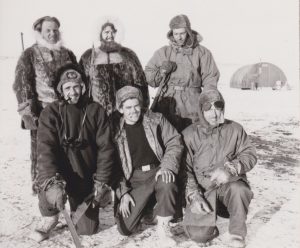 To limit the discussion about JAWS to the realm of diplomacy and sovereignty – as most academics have done to date – misses the opportunity to gain significant insights into the practice of polar science during the Cold War. This research project explores the changing ways in which science was conducted, as well as the interactions between JAWS staff and outside researchers using the stations as hubs to conduct other experiments. Another key theme relates to social life at remote stations. We explore scientific practices, leisure activities, and perceptions of the land and climate, as well as debates over alcohol, hunting, leadership, and command and control. Furthermore, our study examines the complicated logistics associated with re-supply of these stations and the gradual process of “Canadianization” that occurred.
To limit the discussion about JAWS to the realm of diplomacy and sovereignty – as most academics have done to date – misses the opportunity to gain significant insights into the practice of polar science during the Cold War. This research project explores the changing ways in which science was conducted, as well as the interactions between JAWS staff and outside researchers using the stations as hubs to conduct other experiments. Another key theme relates to social life at remote stations. We explore scientific practices, leisure activities, and perceptions of the land and climate, as well as debates over alcohol, hunting, leadership, and command and control. Furthermore, our study examines the complicated logistics associated with re-supply of these stations and the gradual process of “Canadianization” that occurred.
Contrary to the insistence of previous scholars, our study reveals that Canadian officials sought and achieved a firm policy that assured effective control of Canada’s Arctic while enjoying the advantages of American contributions to the joint meteorological system. At the same time, this history will shed significant light onto what Michael Bravo describes as the “changing political entanglement between science and policy in the polar regions” during the Cold War, as well as socio-cultural, political, and ethical dimensions of scientific practices themselves.
I am completing this project with Dr. Daniel Heidt. We submitted our manuscript to a leading university press in summer 2020.
Contemporary Arctic Sovereignty and Security Issues
Climate change is fundamentally reshaping the Arctic region. Boundary disputes, newly viable transportation routes, access to resources, and governance issues generate significant questions about Arctic security and circumpolar geopolitics in the twenty-first century. 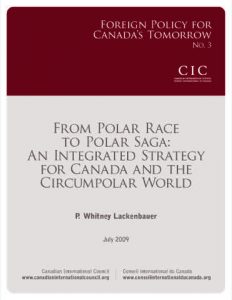 Anticipating future prospects for competition, conflict and cooperation in the region requires a systematic examination of the forces at play, both internationally and domestically.
Anticipating future prospects for competition, conflict and cooperation in the region requires a systematic examination of the forces at play, both internationally and domestically.
My research on current sovereignty and security issues explores opportunities for enhanced bilateral and multilateral cooperation in the circumpolar world by studying the intersections between Canadian foreign and defence policies and how these relate to those of other Arctic states. By supplementing positivist analysis with a “constructivist” approach that critically interrogates the process by which security issues are identified and framed within a dominant sovereignty discourse, and by exploring foreign perceptions of Canada’s Arctic policies, I critically examine how governments set policy priorities and sustain political and public support for their Arctic agendas. Given the myriad audiences interested in this work, I regularly produced academic publications, as well as policy papers and opinion pieces in the popular media.
In 2008, I won a national competition for a Canadian International Council (CIC) research fellowship to critically examine Arctic affairs and to produce a “white paper” to guide Canadian Arctic policy. My 93-page, peer-reviewed report From Polar Race to Polar Saga: An Integrated Strategy for Canada and the Circumpolar World, released in July 2009, received extensive media and academic coverage. Although direct influences on policy are difficult to gauge, a comparison between my report and the March 2010 federal Statement on Canada’s Arctic Foreign Policy reveals many similarities, and one of the federal political parties based their 2011 campaign platform on the Arctic upon my findings. Distinguished German political scientist Helga Haftendorn favourably reviewed my report in International Journal in Autumn 2009.
In 2010, I proposed to the other CIC Arctic fellows – leading political scientists Franklyn Griffiths and Rob Huebert – that we co-author a book, based upon our CIC papers, to stimulate further public debate in Canada on circumpolar affairs. 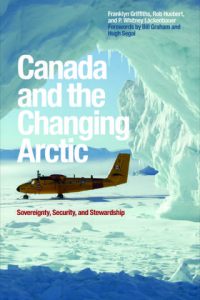 In contrast to Huebert, who highlights international competition and anticipates Arctic conflict, my contributions to Canada and the Changing Arctic: Sovereignty, Security and Stewardship urged Canada to rein in its alarmist rhetoric about alleged sovereignty and security threats. I argued that there is no “Arctic race” and solutions to boundary disputes will be negotiated, not won or lost through military posturing. To devise a more confident and constructive Arctic strategy, Canada needs to marry its defence and resource development agenda with stronger diplomatic and social dimensions.
In contrast to Huebert, who highlights international competition and anticipates Arctic conflict, my contributions to Canada and the Changing Arctic: Sovereignty, Security and Stewardship urged Canada to rein in its alarmist rhetoric about alleged sovereignty and security threats. I argued that there is no “Arctic race” and solutions to boundary disputes will be negotiated, not won or lost through military posturing. To devise a more confident and constructive Arctic strategy, Canada needs to marry its defence and resource development agenda with stronger diplomatic and social dimensions.  A 3-D (defence-diplomacy-development) approach that recognizes the possibility for international cooperation, fixates less on potential “sovereignty loss” and encourages sustainable socio-economic development will place Canada in a better position to seize opportunities and become a world leader in circumpolar affairs. I suggested that a return to Cold War rhetoric and a reactive, crisis-based mentality cannot resolve Arctic problems and inhibits Canadian efforts to seize opportunities in collaboration with northern residents. What Canada can anticipate and should seek is an “Arctic Saga,” predicated on a greater demand for resources and trade coupled with stable governance, rather than an “Arctic race.” To achieve this desired outcome, I encourage the government to focus on sustainable development, constructive circumpolar engagement and environmental protection, without sacrificing either sovereignty or security.
A 3-D (defence-diplomacy-development) approach that recognizes the possibility for international cooperation, fixates less on potential “sovereignty loss” and encourages sustainable socio-economic development will place Canada in a better position to seize opportunities and become a world leader in circumpolar affairs. I suggested that a return to Cold War rhetoric and a reactive, crisis-based mentality cannot resolve Arctic problems and inhibits Canadian efforts to seize opportunities in collaboration with northern residents. What Canada can anticipate and should seek is an “Arctic Saga,” predicated on a greater demand for resources and trade coupled with stable governance, rather than an “Arctic race.” To achieve this desired outcome, I encourage the government to focus on sustainable development, constructive circumpolar engagement and environmental protection, without sacrificing either sovereignty or security.
In the book conclusions, I furnish a detailed overview of the government’s Northern Strategy as well as subsequent domestic and international developments related to the Arctic up to and including the release of the Statement on Canada’s Arctic Foreign Policy in August 2010. Rather than seeking “consensus” I invite ongoing debate amongst Canadians as to what we should be doing in our Arctic front yard – and the region beyond. This book has also been translated into French and was published by Presses de l’université Laval in 2015 under the title Le Canada et la transformation de l’Arctique : Souveraineté, sécurité et intendance.
To reach international audiences, I have published aspects of my CIC research as separate articles, including a chapter in influential American international lawyer James Kraska’s edited volume on Arctic Security in an Age of Climate Change and international publications such as Atlantisch Perspectief. In these contributions, I emphasize the compatibility between investments in improved Arctic military capabilities (which can contribute to safety and regional stability) and an unfolding “Arctic Saga” rooted in cooperation. Nevertheless, balancing an Arctic security agenda with domestic imperatives to improve the quality of life of Northerners, and converting a broad strategy into deliverables that produce a more constructive and secure circumpolar world, are real challenges facing Canada in the twenty-first century Arctic.
To further this research agenda, I proposed a research program on the Emerging Arctic Security Environment with Huebert and international law scholar Suzanne Lalonde (Université de Montréal) to ArcticNet, a federally-funded network of centres of excellence, in 2008.  Our ArcticNet project asks fundamental questions: what is Arctic security? What should policy makers anticipate that the circumpolar world will look like in the future, given the various forces transforming this region? We attempt to discern what senior government officials, indigenous groups, corporate interests, scientists, academics, and Northern residents perceive to be the most significant security and safety challenges in the Arctic, and to determine what unilateral, bilateral and multilateral mechanisms should be in place to address them. Accordingly, our project makes two primary contributions: one policy focused and the other academic. First, our publications and presentations add to the public policy debate about the evolving Arctic security environment. Our research team critically assesses the interplay between traditional, state-based military security and environmental, health, and societal security concerns. In linking international and domestic security practices to human impacts, we seek to improve Canada’s capacity to deal with external challenges while better integrating Northerners’ concerns and priorities. Second, this project advances academic debates about how best to understand the relationship between environmental, political, and socio-economic processes that are changing ideas about Arctic security. Community consultations ground our analyses of how the changing geopolitics of the Arctic impact Northerners’ culture, well-being, and economies. We are refining existing frameworks and models to incorporate the complexity of these new forces, to better explain the actions being taken, and to generate appropriate lessons for future relationship-building. In improving our understanding of past and present sovereignty and security considerations, this project encourages the implementation of a Canadian northern strategy that reflects Northerners’ interests, aligns with the interests of the other Arctic states, and anticipates the rising interest of non-Arctic stakeholders in the region so that they are engaged appropriately.
Our ArcticNet project asks fundamental questions: what is Arctic security? What should policy makers anticipate that the circumpolar world will look like in the future, given the various forces transforming this region? We attempt to discern what senior government officials, indigenous groups, corporate interests, scientists, academics, and Northern residents perceive to be the most significant security and safety challenges in the Arctic, and to determine what unilateral, bilateral and multilateral mechanisms should be in place to address them. Accordingly, our project makes two primary contributions: one policy focused and the other academic. First, our publications and presentations add to the public policy debate about the evolving Arctic security environment. Our research team critically assesses the interplay between traditional, state-based military security and environmental, health, and societal security concerns. In linking international and domestic security practices to human impacts, we seek to improve Canada’s capacity to deal with external challenges while better integrating Northerners’ concerns and priorities. Second, this project advances academic debates about how best to understand the relationship between environmental, political, and socio-economic processes that are changing ideas about Arctic security. Community consultations ground our analyses of how the changing geopolitics of the Arctic impact Northerners’ culture, well-being, and economies. We are refining existing frameworks and models to incorporate the complexity of these new forces, to better explain the actions being taken, and to generate appropriate lessons for future relationship-building. In improving our understanding of past and present sovereignty and security considerations, this project encourages the implementation of a Canadian northern strategy that reflects Northerners’ interests, aligns with the interests of the other Arctic states, and anticipates the rising interest of non-Arctic stakeholders in the region so that they are engaged appropriately.
By bringing historical, legal, and political science frameworks and methodologies to bear on readings of the evolving Arctic security environment, my contributions to this research program challenge widely held assumptions about Canada’s relationships with the United States and other Arctic states. As discussed in the previous section, historical case studies suggest that Canada did a more successful job balancing sovereignty and security imperatives than scholars often assert. The revised narrative that I am producing, which undergirds my approach to current political and policy dilemmas, emphasizes international cooperation and provides a solid basis for a confident and enhanced security relationships without undue concern that these erode Canadian sovereignty.
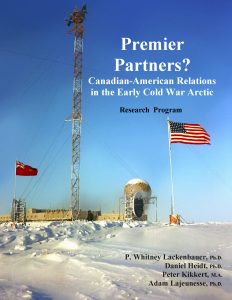 Rob Huebert and I published an article along these lines in Canadian Foreign Policy Journal in 2015. In “Premier Partners: Canada, the United States, and Arctic Security,” we observe how both Canada and United States have developed extensive Arctic security policy frameworks that affirm the rising geopolitical profile of the region, reveal their assumptions and priorities, and indicate an evolution in how regional security is understood. Our analysis of strategic documents produced by both countries since 2006 reveals that the two countries’ evolving strategies and overarching national security objectives are well aligned, highlighting the advancement of security interests, pursuit of responsible stewardship, and strengthened international cooperation. Both countries stand to benefit from leveraging investments that enhance existing relationships, given their long history of cooperation and shared interests in continental defence and Arctic security.
Rob Huebert and I published an article along these lines in Canadian Foreign Policy Journal in 2015. In “Premier Partners: Canada, the United States, and Arctic Security,” we observe how both Canada and United States have developed extensive Arctic security policy frameworks that affirm the rising geopolitical profile of the region, reveal their assumptions and priorities, and indicate an evolution in how regional security is understood. Our analysis of strategic documents produced by both countries since 2006 reveals that the two countries’ evolving strategies and overarching national security objectives are well aligned, highlighting the advancement of security interests, pursuit of responsible stewardship, and strengthened international cooperation. Both countries stand to benefit from leveraging investments that enhance existing relationships, given their long history of cooperation and shared interests in continental defence and Arctic security.
In addition to my work on Canada-US relations, I have published preliminary work on Canada’s relationship with its largest circumpolar neighbour: Russia. “Mirror Images? Canada, Russia, and the Circumpolar World,” an invited article published in Canada’s premier journal on foreign policy, offered a fresh look at Canadian and Russian approaches to circumpolar affairs, and has been reprinted in a volume by American Arctic scholar Barry Scott Zellen. My central message is that the rhetorical dance between Canada and Russia over Arctic issues, rich in mixed messaging, can serve the complex political interests of both parties if it is carefully choreographed. Both governments have indicated their desires to revitalize their military forces. This requires national will, and Russian and Canadian politicians are tapping into identity politics to justify investments in military capabilities for the defence of sovereignty. In this sense, rhetorical jousting serves political interests in both countries, and the primary audiences are domestic.
My recent work also critically examines non-Arctic countries’ emerging interests in Arctic affairs. In particular, Asia’s growing interest in the region has attracted global attention. Most international media and academic commentary fixates on China, given its dramatic economic rise and the widely held misperception that it claims some portion of the Arctic Ocean. With increased Asian pressure for access to circumpolar discussions, questions abound whether the existing suite of Arctic governance institutions is sufficiently robust and inclusive to deal with regional challenges in the twenty-first century. My publications with political scientist James Manicom (Centre for International Governance Innovation) suggest that non-Arctic states have legitimate interests in (and can make substantive contributions to) the region, as long as they respect the Arctic states’ sovereignty and sovereign rights to exclusive economic zones (EEZs) and extended continental shelves as scripted in international law.
China’s Arctic Ambitions and What They Mean for Canada, which I co-wrote with Adam Lajeuensse, James Manicom, and Frederic Lasserre, is the first book dedicated to exploring China’s interest in the Arctic, with a particular focus on Canada’s Far North. It critically examines China’s scientific, environmental, economic, and security interests and activities in the Arctic region and, through a Canadian lens, explores how these intersect with the interests of Arctic states and Northern peoples, and Canadian defence requirements over the next decade.
Although the Chinese government has not produced an Arctic strategy to date, Chinese scientists and academics have indicated a growing interest in the environmental, resource, economic, and security aspects of an increasingly open and navigable Arctic as climate change reshapes the region. Although China is not an Arctic littoral (coastal) state, it has shown a keen interest in becoming involved in regional bodies like the Arctic Council (for which it has secured Observer status) as well as discussions about the regulation and management of Arctic resources. Despite its aspirations as a self-declared “near Arctic state,” China’s activities and official policies with regard to the region have remained relatively low-profile. Still, there are indications that this may change in the next decade.
To understand this shift, we have undertaken extensive research into published Chinese government documentation, secondary source analyses, business and media reports, and the existing academic literature. We eschew the traditional analytical framework, which assumes that Chinese actions are the result of a unified, monolithic body and, instead, look at the different and often competing interests and priorities of the various components of Chinese government and industry. In so doing, we gain a more accurate picture of China’s decision making process and how that process applies to its Arctic activities. This manuscript is the first to attempt this sort of analysis through a Canadian lens. While the work examines Chinese activities and interests throughout the circumpolar region, the intent in doing so is to place China’s interests (and potential interests) in Canada in perspective.
To date, India’s Arctic ambitions have attracted less academic and popular attention in the Arctic states. Indian commentators have hailed their country’s successful application for observer status at the Arctic Council (approved by the Arctic member states at the Kiruna ministerial meeting in May 2013) as an “Arctic victory” and “a major diplomatic achievement” for foreign minister Salman Khursid. Most Indian commentators agree that responsible environmental management and cooperative scientific research and exploration are essential to any Arctic governance regime. What do they mean when they refer to the Arctic as a “global commons”? How do they interpret the relevance of scientific research in the region, Arctic resource assessments, and prospects for investments or new technological capabilities to exploit these resources? How does China’s growing interest in the Arctic, and the most basic question of prestige, factor into India’s Arctic outlook? To introduce the contours of popular and academic debate on Arctic issues in India, my chapter in the 2013 Arctic Yearbook critically examines the writings of five Indian commentators and how they situate Arctic issues in a global perspective rather than the national or regional perspective that dominates most commentaries emanating from the Arctic states. For Arctic scholars and policy-makers to better understand what appear to be peculiar (and even confrontational) positions on regional issues, I encourage them to look to India’s experiences in Antarctica and Svalbard, broader geostrategic interests, and the corresponding frames that Indian thinkers apply to geopolitics and governance in the Arctic.
The Canadian Rangers
Northern peoples insist that sovereignty “begins at home.” For six decades, the Canadian Rangers — a dedicated group of citizen-soldiers — have quietly served as Canada’s eyes, ears, and voice in isolated coastal and northern communities. My studies, reflecting extensive archival and field research on and with the Rangers over the last decade, demonstrate how and why the Rangers represent an important success story for the military as a flexible, inexpensive, and culturally inclusive organization. As a bridge between cultures and between the civilian and military realms, the Rangers have evolved to represent a successful integration of national security and sovereignty agendas with community-based activities and local stewardship. This practical partnership, rooted in traditional knowledge and skills, promotes cooperation, communal and individual empowerment, and cross-cultural understanding.
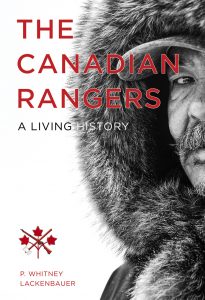 My book The Canadian Rangers: A Living History (UBC Press, April 2013) is the culmination of more than a decade of research. Drawing upon official records, extensive interviews, and on-the-ground participation in Ranger exercises from coast to coast to coast, this study demonstrates how this minimally trained and lightly equipped force makes a meaningful contribution to national defence and to sustainable communities. Having become a flexible, inexpensive, and culturally inclusive way for Canada to “show the flag,” the Rangers offer living proof that military activities designed to assert sovereignty need not cause insecurity for residents of remote regions. Local knowledge, stewardship, and national security prove compatible and mutually reinforcing.
My book The Canadian Rangers: A Living History (UBC Press, April 2013) is the culmination of more than a decade of research. Drawing upon official records, extensive interviews, and on-the-ground participation in Ranger exercises from coast to coast to coast, this study demonstrates how this minimally trained and lightly equipped force makes a meaningful contribution to national defence and to sustainable communities. Having become a flexible, inexpensive, and culturally inclusive way for Canada to “show the flag,” the Rangers offer living proof that military activities designed to assert sovereignty need not cause insecurity for residents of remote regions. Local knowledge, stewardship, and national security prove compatible and mutually reinforcing.
I consider this book my single most important academic achievement to date.
In recognition that an academic book will not be appealing to all Ranger audiences, I wrote Vigilans: The 1st Canadian Ranger Patrol Group for 1 CRPG which was published in 2015. This illustrated history offers a more accessible narrative, focused on the Rangers in the Territorial North, celebrating their contributions to Arctic sovereignty, security, and safety. Prime Minister Stephen Harper, an Honorary Ranger, generously provided a foreword to this book and was presented the first draft copy during his visit to Operation Nanook 2014.
More broadly, my publication on the Rangers trumpet them as a clear example of a relationship that the government actually gets right. My chapter “Aboriginal Peoples in the Canadian Rangers: Canada’s ‘Eyes and Ears’ in Northern and Isolated Communities” provides an accessible overview charting Aboriginal participation in the Canadian Rangers. “Canada’s Northern Defenders: Aboriginal Peoples in the Canadian Rangers, 1947-2005” charts a similar course, albeit in greater detail, and highlights evolving military perceptions about contributions that northern Aboriginal peoples can make to national defence. The documentary record suggests that the Canadian military historically possessed conflicting ideas about the role and utility of Aboriginal peoples in the Rangers – and the CF more generally. By the late 1970s, however, new sovereignty and security discourses encouraged the military to integrate Aboriginal peoples in culturally appropriate ways. Officials saw operational value in traditional skills and the military realized that diversity can serve as a “force multiplier” rather than a liability. Over the last two decades, this understanding allowed the Rangers to flourish in the north, attract significant positive media attention for the military, and support self-governing and sustainable northern communities.
Having accumulated a large collection of newspaper and magazine articles on the Rangers, I approached the Canadian Forces Leadership Institute in 2010 about editing a book that uses media coverage to highlight the many activities in which the Rangers have been involved, reveal how the organization evolved, and affirm the Rangers’ positive influence throughout Canada. I intended Canada’s Rangers: Selected Stories, 1942-2012 to serve as a “commemorative” volume, produced with the Rangers and their host communities in mind, celebrating the Rangers’ contributions to their communities and their country over the last seven decades. It was planned for release on the 65th anniversary of the organization in October 2012, but owing to resource constraints at Canadian Defence Academy Press it was not printed until the spring of 2013.
I also framed two scholarly publications with a specific view to reaching policy-makers. My oft-cited article “The Canadian Rangers: A Postmodern Militia That Works” discusses theoretical traits associated with “postmodern” military formations to explain the vitality and success of the Canadian Rangers. “Teaching Canada’s Indigenous Sovereignty Soldiers … and Vice Versa: ‘Lessons Learned’ from Ranger Instructors” analyzes specific relationships and practices that have evolved vis-à-vis military instructors’ experiences in isolated Canadian northern and coastal communities. The genesis of this article came from 1 Canadian Ranger Patrol Group, which suggested that I write an article on Ranger instructors and their responsibilities in the north that would be accessible to serving members of the Canadian Forces and policy-makers in the Department of National Defence.
The Rangers prove that modest, grassroots measures can assert a national presence over Arctic lands and waters. Northerners exercise jurisdiction and control and demonstrate that traditional indigenous activities continue unbroken to the present. My work advises politicians to be careful lest they set up the Rangers to fail by asking too much of them or trying to over-militarize them. Serving Rangers believe that the organization already strikes an appropriate balance between local, regional, and national priorities. The danger with a success story is that, in trying to improve it, you can end up breaking something that is not broken.
Indigenous-Newcomer Relations in Canada
I maintain a strong interest in Native-Newcomer relations in Canada, with particular emphasis on relationships between Aboriginal peoples and the Canadian military. My work on the Canadian Rangers is an example of this, as are various other projects.
Aboriginal Peoples and the Canadian Military
In late 2006, UBC Press published my first major monograph, Battle Grounds: The Canadian Military and Aboriginal Lands, which focused on the military’s use of Indian reserve lands and First Nations traditional territories for training. 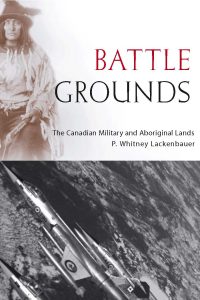 The Royal Commission on Aboriginal Peoples drew specific attention to this subject, pointing to the 1942 appropriation of Stony Point Indian reserve and the unjustified postwar retention of Camp Ipperwash as the prime example of government perfidy and callous disregard for Native rights. I painted a similar (but more nuanced) picture of the Ipperwash case, but cautioned that the government’s measures could not be generalized to other land use arrangements. Instead, the history of Native-Newcomer relations needed to recognize and reconsider the contradictions and complexities that mark relationships across time and space. Assessing more than a dozen case studies from across Canada, this ambitious, interdisciplinary project charted evolving political relationships between National Defence, the Department of Indian Affairs, and Native communities in a comparative manner, providing important insights into government behaviour, expressions of communal and individual agency, and legal, political, socio-economic and environmental legacies stemming from military use. The final section explored the emergence of Native land claims and litigation in historical context, and the concomitant effects on relationships and memory. The results challenged prevailing depictions of the various participants, providing an important commentary on war and society and Native-Newcomer relations in Canada.
The Royal Commission on Aboriginal Peoples drew specific attention to this subject, pointing to the 1942 appropriation of Stony Point Indian reserve and the unjustified postwar retention of Camp Ipperwash as the prime example of government perfidy and callous disregard for Native rights. I painted a similar (but more nuanced) picture of the Ipperwash case, but cautioned that the government’s measures could not be generalized to other land use arrangements. Instead, the history of Native-Newcomer relations needed to recognize and reconsider the contradictions and complexities that mark relationships across time and space. Assessing more than a dozen case studies from across Canada, this ambitious, interdisciplinary project charted evolving political relationships between National Defence, the Department of Indian Affairs, and Native communities in a comparative manner, providing important insights into government behaviour, expressions of communal and individual agency, and legal, political, socio-economic and environmental legacies stemming from military use. The final section explored the emergence of Native land claims and litigation in historical context, and the concomitant effects on relationships and memory. The results challenged prevailing depictions of the various participants, providing an important commentary on war and society and Native-Newcomer relations in Canada.
I have published several articles on Aboriginal-military relations related to land use that explore how competing national and local agendas, identities, and personal interests both confirm and challenge generalizations in the existing historiography. For example, my article in the Journal of the Canadian Historical Association reassessed the Mohawk Workers’ vocal opposition to a proposed airbase at Six Nations in 1940, revealing that it succeeded in convincing the federal government to take its plans elsewhere (despite the expropriation powers available to the Crown). I argued that this case – cast by the Royal Commission on Aboriginal Peoples as an example of government perfidy – demonstrates how the existing historiography on Native-military and Native-Newcomer relations is too prone to narrating Aboriginal-military relations as simple tragedy. I urge scholars to embrace irony and contradiction. This article won the 2005 Journal of the CHA award, with the citation noting:
This paper successfully intertwines local history, Native history, and the Canadian experience during the Second World War. It challenges accepted interpretations and presents a nuanced interpretation of motivations within the aboriginal community and among federal government officials. The paper serves as a reminder that historians should embrace complexity in historical events, and presents a striking example of what can be achieved through using this approach.
Individual experiences also challenge assertions of a generalizable “Native” history. Partly as a result of teaching a first-year course in Canadian history through biography, I have developed a strong interest in biographical construction of national heroes. Tommy Prince was one of the most decorated non-commissioned officers in Canadian military history and has become the quintessential “Indian at War:” the archetype of Aboriginal contributions to the wars. In biographical terms, his story is tragic: that of a soldier whose commitment to his people and his country was never matched by his country’s support for him. Overseas he was a bold, audacious and courageous warrior. At home, he was a “fallen hero,” fated to spend his final years as an alcoholic on the streets of Winnipeg. Prince has become Canada’s version of Ira Hayes – the American Indian soldier immortalized in Johnny Cash’s famous ballad. In an article and book chapter, I made the case that Prince suffered from post-traumatic stress disorder. Acknowledging that Prince ended up a psychological casualty does not diminish his heroism or his courage. Instead, I argue that his story serves as a reminder that operational stress preys upon even the most committed soldiers. How one chooses to prioritize Prince’s identities – as a Native soldier or a soldier who was Native – influences the way that historians explain his difficult experiences: either as a victim of racism and inequitable power structures preying upon Aboriginal peoples, or the lamentable neglect of veterans who bore the psychological scars of war. In Prince’s case, it was probably both.
With Dr. Scott Sheffield, assistant professor of history at University College of the Fraser Valley, I critically assessed the literature on Canadian Aboriginal peoples and the World Wars over the last quarter century. For decades, Aboriginal veterans struggled for recognition and compensation for unequal treatment compared to their non-Native compatriots. These struggles bore fruit, garnering traction within veterans’ own communities and later governments, media and the scholarly community. This context meant their experiences have been deeply politicized and narrated through government-sponsored research, parliamentary reports and the Royal Commission on Aboriginal Peoples. Consequently, we argued that Aboriginal peoples who fought in the World Wars are no longer forgotten warriors/soldiers – even though most commentators still refer to them that way. The time is right for reassessment and self-reflection, which entails moving beyond “forgotten” and enriching our understandings of what the wars meant to Aboriginal peoples and what Aboriginal peoples’ contributions meant for the war efforts.
To deliver on one of these suggestions, I invited undergraduate research assistant Katharine McGowan to co-author a paper on “Competing Loyalties in a Complex Community: Enlisting the Six Nations in the Canadian Expeditionary Force, 1914-1917.” We demonstrated how Six Nations’ participation in the Canadian war effort was neither a simple and universal expression of loyalty, nor was it a signal of the band’s acceptance of assimilation. The Hereditary Council’s caution in (and resistance to) supporting the Canadian war effort reflected deeply rooted political and social dynamics in the community, which inhibited recruiting efforts. A complex and divided community that responded to the war effort in different ways. Even on the intensely local level, characterizing a monolithic “Aboriginal” response to the war would be as fallacious as imposing such uniformity on Canada as a whole.
In 2006, the Canadian Forces Leadership Institute contracted me to produce two co-edited volumes on Aboriginal Peoples’ participation in armed forces, emphasizing Canada and other “British settler societies.” The first volume traces Aboriginal-military relationships in Canada from the early days of New France to the 21st century Arctic, and it highlights the important roles that Aboriginal people have played in the defence of the nation: from valued allies, to “specialist” fighters, to forgotten veterans, to defenders of Canada’s north. The second volume recognizes that these historical and contemporary relationships are seldom explored beyond the narrow confines of our own national experience, although there have been parallels in other indigenous populations that are worthy of serious reflection. The chapters contribute to cross-cultural awareness by offering a critical, comparative approach to understanding Aboriginal peoples’ military service in Canada and around the world. (I contributed four chapters to these volumes as author or co-author, as well as a detailed introduction to volume one which placed the specific chapters in broader historical context.)
Finally, I wrote “Carrying the Burden of Peace: The Mohawks, the Canadian Forces, and the Oka Crisis” for the Canadian Forces Leadership Institute strategic writing project to situate the military’s involvement in historical context and analyse Canadian Forces leadership during Operation SALON using after action reports obtained through Access to Information and first-hand accounts of the operation. This article has stimulated debate, including some critical responses — see, for example, A. Conradi, “Uprising at Oka,” Canadian Journal of Communication 34/4 (2009), 547-50, and M.C. Anderson and C.L. Robertson, Seeing Red: A History of Natives in Canadian Newspapers (2011), 223-24 — which reveal epistemological differences more than substantive critiques of my work.
To reach a broad public audience, particularly for commemorative purposes, I acknowledge that historians need to generalize. In 2004, the Department of National Defence, Directorate of History and Heritage, contracted me to serve as lead author and project coordinator for A Commemorative History of Aboriginal Peoples in the Canadian Military. Written with Scott Sheffield, Maxime Gohier, and John Moses, this narrative overview is richly illustrated and published in a “coffee-table” format.
Indigenous Activism and the Canadian State
At the core of Canada’s identity as a diplomatic actor is the image of good international citizenship, but Indigenous people’s/peoples’ issues highlight the gap between this self-image and flaws in its record. As I have traced in an article with Andrew F. Cooper, professor of political science at the University of Waterloo, this question is an embedded structural predicament: it juxtaposes the mainstream identity of Canada as a country with a colonial past and the identity among the Indigenous peoples of Canada as territorial occupants. This article revealed how Indigenous representatives, borrowing some of the most Canadian habits of diplomacy, have adopted blame and shame tactics designed to exploit Canadian discomfort. The seriousness with which Canadian diplomats dealt with these challenges is striking. Using historical and contemporary case studies, this article unpacked and analysed evolving strategies to assert and constrain Indigenous rights and forces on the international stage.
The Canadian government’s relationship with Indigenous groups has also stimulated confrontation domestically. Scholars have documented forms of Indigenous peoples’ agency from “everyday resistance” to direct action against the authority of the nation-state. 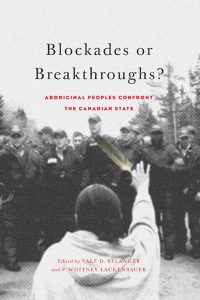 While Indigenous blockades have been a relatively common occurrence since 1970, and have elicited much commentary from journalists and public officials, scholarly literature on the phenomenon is surprisingly sparse. The adoption of direct action tactics like blockades and occupations is predicated on the idea that something is needed to break an unfavourable status quo, and that the outcome can be a favourable one. But do blockades and occupations work? Are they “breakthroughs”? What are the objectives (political, territorial, socio-economic, and ideological) of Indigenous people and communities who adopt this approach? How can success be measured? Blockades or Breakthroughs? Aboriginal Peoples Confront the Canadian State, which I co-edited with Yale Belanger (Native American Studies, University of Lethbridge), provides deeper analysis rooted in appreciation of the complexity of Indigenous communities, governments, other stakeholders – and the interactions between these protagonists.
While Indigenous blockades have been a relatively common occurrence since 1970, and have elicited much commentary from journalists and public officials, scholarly literature on the phenomenon is surprisingly sparse. The adoption of direct action tactics like blockades and occupations is predicated on the idea that something is needed to break an unfavourable status quo, and that the outcome can be a favourable one. But do blockades and occupations work? Are they “breakthroughs”? What are the objectives (political, territorial, socio-economic, and ideological) of Indigenous people and communities who adopt this approach? How can success be measured? Blockades or Breakthroughs? Aboriginal Peoples Confront the Canadian State, which I co-edited with Yale Belanger (Native American Studies, University of Lethbridge), provides deeper analysis rooted in appreciation of the complexity of Indigenous communities, governments, other stakeholders – and the interactions between these protagonists.
Canadian Military History
I consider myself a military historian, although my research interests are oriented towards socio-cultural aspects of military service and war rather than operational analysis. In addition to the work discussed above, I have produced studies examining war and memory, soldier-civilian relations on the Canadian home front, war crimes trials, and military base closures. For example,
I am interested in the construction of wartime myths and how these are integrated into postwar narratives. For example, my 1999 Newfoundland Studies article, “War, Memory, and the Newfoundland Regiment at Gallipoli,” won the Institute for Social and Economic Research (ISER) Student Essay Prize as that year’s outstanding contribution to the study of Newfoundland. By integrating operational, social, and “war and memory” analysis, this essay provided an innovative framework for understanding the construction of experience and remembrance in a holistic manner.
I am also interested in relationships between soldiers and their home communities. For example, in 1916, ill-disciplined soldiers of the Canadian Expeditionary Force took to the streets and battled with local authorities on “various patriotic pretexts”: standing up to pernicious “enemy alien” or anti-military currents, perceived civilian encroachment on military jurisdiction, and sundry injustices that upset their rudimentary understanding of their soldierly mission and roles. My initial articles in Alberta History and Canadian Military History examined soldier “riots” in Calgary using anthropological theory on rites of passage. My book chapter “Soldiers Behaving Badly” compares eleven cases of domestic disobedience, revealing obvious motivations of ethnic intolerance and patriotism, along with alcohol, over-zealous camaraderie and weak military leadership. While the domestic “riots” varied in severity, the sheer number of episodes and men involved revealed a serious problem. Most of the rioting soldiers were new recruits not yet indoctrinated in the strict discipline and hierarchical control demanded by military life. As citizen-soldiers-in-the-making, they could not disengage from their civilian referents and misapplied their unique role as the “social guardians” of society (as well as primary group loyalties to their uniformed mates). The training of newly recruited (or recruiting) battalions in their places of origin created a liminal space for soldiers. They recognized their familiar surroundings, but through the eyes of a neophyte citizen-soldier inculcated with a budding military ethos of loyalty, teamwork and bold action. The military’s failure to isolate the soldiers from civil society, coupled with an insufficient discipline, control and leadership, led to breakdowns in military command and social control in 1916. Senior officers’ refusal to take responsibility for recalcitrant soldierly behaviour, and the military’s refusal to acknowledge their soldierly identities, undermined the military ethos of collective responsibility. (I am developing this chapter into a short book which I hope to have published in 2016 – the centenary of these events.)
Questions of military leadership and command responsibility intersect with my work on Canada’s involvement in war crimes trials after the Second World War. My major work on the topic, Kurt Meyer on Trial, is a massive co-edited volume with Dr. Chris Madsen (Department of Defence Studies, Canadian Forces College). 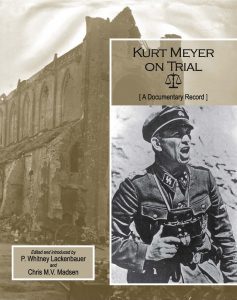 This volume is framed around the late 1945 Canadian military court sitting in occupied Germany which convicted Waffen-SS General Kurt Meyer on charges related to the murder of Canadian prisoners of war in Normandy. It was Canada’s first entry into the war crimes field and the trial raised important operational and legal issues, particularly with regard to command responsibility. Although sentenced to death by firing squad, a controversial decision of Canadian military authorities to commute the sentence and Meyer was released after less than a decade of imprisonment in New Brunswick and West Germany. Meyer’s war crimes trial and the final result caused consternation and outrage amongst the Canadian public at the time and remains among the most controversial episodes in Canadian military history. This collection brought together previously unpublished documents related to Canada’s prosecution of Kurt Meyer, including the original trial transcript and selected materials to situate the trial in its political, military, diplomatic, and legal context. Augmented by an extensive introduction and bibliography of related works, these documents allow readers to understand the factors that led Canadian authorities to try Meyer for war crimes and to determine for themselves his relative guilt or innocence.
This volume is framed around the late 1945 Canadian military court sitting in occupied Germany which convicted Waffen-SS General Kurt Meyer on charges related to the murder of Canadian prisoners of war in Normandy. It was Canada’s first entry into the war crimes field and the trial raised important operational and legal issues, particularly with regard to command responsibility. Although sentenced to death by firing squad, a controversial decision of Canadian military authorities to commute the sentence and Meyer was released after less than a decade of imprisonment in New Brunswick and West Germany. Meyer’s war crimes trial and the final result caused consternation and outrage amongst the Canadian public at the time and remains among the most controversial episodes in Canadian military history. This collection brought together previously unpublished documents related to Canada’s prosecution of Kurt Meyer, including the original trial transcript and selected materials to situate the trial in its political, military, diplomatic, and legal context. Augmented by an extensive introduction and bibliography of related works, these documents allow readers to understand the factors that led Canadian authorities to try Meyer for war crimes and to determine for themselves his relative guilt or innocence.
Finally, I published on the establishment and closure of military bases in Canada to explore the nexus between national and local politics. In collaboration with political scientist Dr. Lilly Goren (Carroll University), our work on the comparative politics of de-distributive decision-making assessed American and Canadian base closure experiences on national and regional levels to test a neo-institutionalist model. Our research appeared as a short monograph in the Canadian-American Public Policy series, as well as a chapter in a comparative volume on the “politics of pain” edited by prominent policy scholars Les Pal and Kent Weaver.
Norwich Township at War: A Rural Community Experiences the First World War
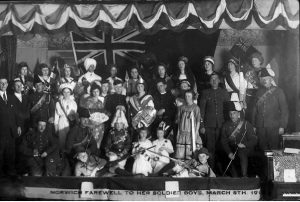 Conducted in partnership with the South Norwich Historical Society, Norwich Historical Society, Emily Stowe Public School, Jennifer Arthur, and Peter Kikkert, this community-based project seeks to produce publicly-accessible histories of the township’s experiences during the First World War through local newspapers, diaries, and government files. This past year, Ms. Arthur and Dr. Kikkert conducted a successful research program in partnership with teachers at Emily Stowe Public School in Norwich to expose students to primary sources and learn about local soldiers and their families during the war. We anticipate that this project will yield two popular books: a general overview history and a collection of correspondence between local soldiers and their families.
Conducted in partnership with the South Norwich Historical Society, Norwich Historical Society, Emily Stowe Public School, Jennifer Arthur, and Peter Kikkert, this community-based project seeks to produce publicly-accessible histories of the township’s experiences during the First World War through local newspapers, diaries, and government files. This past year, Ms. Arthur and Dr. Kikkert conducted a successful research program in partnership with teachers at Emily Stowe Public School in Norwich to expose students to primary sources and learn about local soldiers and their families during the war. We anticipate that this project will yield two popular books: a general overview history and a collection of correspondence between local soldiers and their families.
Canadian Political History
The ideas and concerns that inform a country’s founding inspire and complicate politics for generations. In the United States, Americans can learn about their country’s founding ideas and debates by consulting any one of several published editions of the Federalist Papers, Anti-Federalist Papers, or thematically organized multi-volume sets of thematically organized papers, debates and pamphlets. For Australia’s centenary, the University of Sydney digitized the full texts of that country’s key debates from the 1890s to the 1940s.
Canadians do not enjoy these opportunities. Before each province and territory became a part of Canada, their local legislatures (and the House of Commons after 1867) debated the extent, purposes, and principles of political union between 1865 and 1949. The vast majority of these records, however, remain inaccessible. Indeed, many of the texts can only be found in provincial archives. A few single-volume edited collections exist, but they had to be heavily edited to reduce the cost of printing. In addition to federal and colonial debates, the British Crown also negotiated a series of Numbered Treaties with Canada’s Indigenous Peoples. These texts, and the records of their negotiation, are equally important to Canada’s founding yet, as the Truth and Reconciliation Committee recently explained, “too many Canadians still do not know the history of Indigenous peoples’ contributions to Canada, or understand that by virtue of the historical and modern Treaties negotiated by our government, we are all Treaty people.”
Embracing new research technologies and dissemination formats, Dr. Daniel Heidt spearheaded an initiative (with several leading Canadian political historians) to finally bring all of these debates to every Canadian and preserve them for future generations. By bringing together these diverse colonial, federal, and Indigenous texts for the first time, the project will increase political awareness of historical grievances and contribute to reconciliation.
We have received funding from the Social Sciences and Humanities Council of Canada Connection Grant program, the Crabtree Foundation, and other sources for this important public history project. It reproduces founding parliamentary debates in their entirety, converts them into a TEI database, and provides a website where users can search the texts, read them in e-books, or data mine them by downloading the dataset — all free of charge.
An edited book based upon this project, Reconsidering Confederation, brings together Canada’s leading historians to explore how the provinces, territories, and Treaty areas became the political frameworks we know today. The French-language edition, La Confédération, 1864-1999: Nouvelles perspectives, will be published in 2019. In partnership with The Confederation Debates, an ongoing crowdsourced, non-partisan, and non-profit initiative to digitize all of Canada’s founding colonial and federal records, these books break new ground by integrating the treaties between Indigenous peoples and the Crown into our understanding of Confederation.
My earlier edited work focused on Canadian political history. In September 2002, the University of Calgary Press published my first book, An Inside Look at External Affairs During the Trudeau Years, the edited memoirs of former Secretary of State for External Affairs Mark MacGuigan. 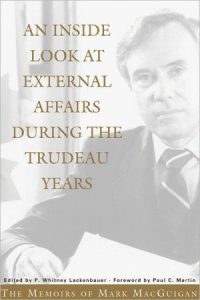 Reviewers noted that this book makes an important contribution to the literature on Canadian constitutional and foreign policy during the Trudeau years.
Reviewers noted that this book makes an important contribution to the literature on Canadian constitutional and foreign policy during the Trudeau years.
Later that year, my co-edited book Mackenzie King: Citizenship and Community with historians John English and Kenneth McLaughlin appeared in print. I contributed a chapter on the Prime Minister William Lyon Mackenzie King’s views on Canadian-American bilateral relations and Canadian sovereignty in the North during and immediately following the Second World War.
Finally, The Hidden Pierre Elliott Trudeau: The Faith Behind the Politics, a co-edited volume with John English and journalist Richard Gwyn, provided unique perspectives on Catholicism in public life based upon a conference held at St. Jerome’s University. Widely reviewed in newspapers and the Catholic media, its first print run sold out in less than a month.
Documentary Film
I have worked with the Canadian Armed Forces on two short videos related to the history of the Canadian Rangers:
Honorary Lieutenant-Colonel Whitney Lackenbauer explores the roles of the Canadian Rangers. Canadian Army News, video, 31 May 2017, project number: 17-0010.
The Pacific Coast Militia Rangers served as the military’s eyes and ears along the Pacific coast, video, 31 May 2017, project number: 17-0075.
I have also supported various documentary film projects as a researcher:
Arctic Defenders. Director John Walker. Historical adviser. 2011-13.
Ridin’ with the Rangers. Director Jimmy Lewis, Vancouver. Interviewed in Vancouver in October 2008. Documentary film.
Canadian Rangers. Director Jon O’Connor, Toronto. Interviewed in Waterloo in December 2008 and provided archival photographic footage for use in the promotional film. Available online as “Soldiers of the North,” Department of National Defence, March 2009.
History’s Courtroom. Interviewed for the episode on the Kurt Meyer trial, October 2002. History TV.
Murder in Normandy. Paperny films. Historical researcher, 1999.
Museum Displays
I have designed the content for two museum displays:
The Canadian Rangers. Prince of Wales Northern Heritage Centre, Yellowknife, NT. Designer, 2018, on display 2018-19.
The Historic Voyages of St Roch. Halifax Maritime Museum, Halifax, NS. Co-designer and editor, 2019 (with Peter Kikkert), on display 2019-20.


